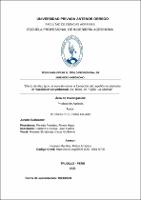Efecto de diez tipos de sustrato sobre la formación del cepellón en plántulas de Vaccinium corymbosum Var. biloxi, en Trujillo -La Libertad

View/
Download
(application/pdf: 1.670Mb)
(application/pdf: 1.670Mb)
Date
2021Author(s)
Flores Cruz, Carlos Eduardo
Metadata
Show full item recordAbstract
Esta investigación tuvo como objetivo determinar el efecto de diez tipos de
sustrato sobre la formación del cepellón en plántulas de Vaccinium corymbosum
Var. Biloxi, en Trujillo -La Libertad. Se emplearon 60 plántulas de arándano
provenientes de cultivo in vitro. En un diseño completamente aleatorizado con
10 tratamientos y 6 repeticiones. T1: Fibra de coco 100%; T2: Fibra de coco 80%
+20% de pajilla de arroz; T3: Fibra de coco 70% +30% de pajilla de arroz; T4:
Fibra de coco 50% +50% de pajilla de arroz; T5: Fibra de coco 80% +20% de
kekkila; T6: Fibra de coco 70% +30% de kekkila; T7: Fibra de coco 50% +50%
de kekkila; T8: Fibra de coco 80% +20% de musgo; T9: Fibra de coco 70% +30%
de musgo; T10: Fibra de coco 50% +50% de musgo. Variables evaluadas: Altura
de planta (AP), Número de hojas (NH), Retención del cepellón (RC) y Longitud
de raíz (LR). Se utilizaron las pruebas de Tukey al 95% de confianza. Los
resultados obtenidos para cada variable fueron: El T10 obtuvo la mayor (AP)
(10,33cm) en comparación a los tratamientos T7, T8 y T9 que obtuvieron (8,53;
9,90 y 8,95 cm) respectivamente, seguido de los tratamientos T1, T5 y T6 que
lograron alturas de (6,60;7,93 y 8,72 cm) respectivamente, los tratamientos que
obtuvieron menor altura fueron el T2, T4 y T3 con valores de (5,02 ;5,30 y 3,82
cm) respectivamente. El T10 obtuvo el mayor número de hojas (11) en
comparación a los tratamientos T7, T8 y T9 que obtuvieron (9,9 y 9)
respectivamente, seguido por los tratamientos T1, T5 y T6 que obtuvieron (7,8 y
8); los tratamientos que obtuvieron menor número de hojas fueron T2, T4 y T3
con 5,5,4 respectivamente. El T10 obtuvo la mayor (LR) (12,27cm) seguido de
los tratamientos T4, T7, T8 y T9 que obtuvieron (6,63; 7,08; 7,9 y 8,15 cm)
respectivamente. Los tratamientos que obtuvieron menor (LR) fueron T1, T5, T2
y T3 con valores de (5,12; 5,07 y 2,33 cm) respectivamente. El T10 obtuvo la
mejor (RC) (82,16g) con una condición de “Excelente” ≥ 76g, seguido por el
tratamiento T9 (63,43g) “Muy bueno” 61-75g y los tratamientos T5, T6, T7y T8
con (43,60; 48,72; 55 y 58,43g) “Bueno” 46-60g. El T1(31,33g)” Regular” 31-45g
y los tratamientos que obtuvieron la menor (RC) fueron T2, T3 y T4 (13,52; 12,37;
9,75g) respectivamente con una condición de “Muy mala” The present research work aimed to determine the effect of ten types of substrate
on the formation of the root ball in seedlings of Vaccinium corymbosum Var.
Biloxi, in Trujillo -La Libertad. 60 blueberry seedlings from in vitro culture were
used. In a completely randomized design with 10 treatments and 6 repetitions.
T1: 100% coconut fiber; T2: 80% coconut fiber + 20% rice straw; T3: 70% coconut
fiber + 30% rice straw; T4: 50% coconut fiber + 50% rice straw; T5:80% coconut
fiber + 20% kekkila; T6: Coconut fiber 70% + 30% kekkila; T7: 50% coconut fiber
+ 50% kekkila; T8: 80% coconut fiber + 20% moss; T9: Coconut fiber 70% + 30%
moss; T10: 50% coconut fiber + 50% moss. Variables evaluated: Plant height
(AP), Number of leaves (NH), Root ball retention (RC) and Root length (LR). The
Tukey tests were used at 95% confidence. The results obtained for each variable
were: The T10 obtained the highest (AP) (10.33cm) compared to the T7, T8 and
T9 treatments that obtained (8.53, 9.90 and 8.95 cm) respectively, followed of
treatments T1, T5 and T6 that achieved heights of (6.60, 7.93 and 8.72
cm)respectively, the treatments that obtained the lowest height were T2, T4 and
T3 with values of (5.02, 5.30 and 3.82 cm) respectively. The T10 obtained the
highest number of leaves (11) compared to the treatments T7, T8 and T9 that
they obtained (9.9 and 9) respectively, followed by the treatments T1, T5 and T6
that they obtained (7.8 and 8); the treatments that obtained the lowest number of
leaves were T2, T4 and T3 with 5.5.4 respectively. The T10 obtained the highest
(LR) (12.27cm) followed by the T4, T7, T8 and T9 treatments that obtained (6.63,
7.08, 7.9 and 8.15 cm) respectively. The treatments that obtained the lowest (LR)
were T1, T5, T2 and T3 with values of (5.12, 5.07 and 2.33 cm) respectively. T10
obtained the best (CR) (82.16g) with a condition of “Excellent” ≥ 76g, followed by
treatment T9 (63.43g) “Very good” 61-75g and treatments T5, T6, T7 and T8 with
(43.60; 48.72; 55 and 58.43g) “Good” 46-60g. The T1 (31.33g) ”Regular” 31-45g
and the treatments that obtained the lowest (CR) were T2, T3 and T4 (13.52;
12.37; 9.75g) respectively with a condition of “Very bad
Subject
Collections
- Ingeniería Agrónoma [99]

